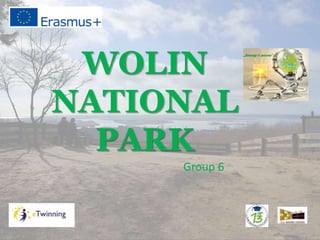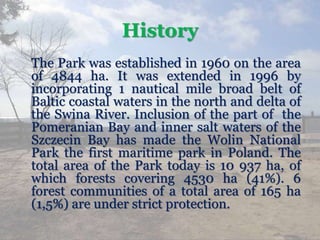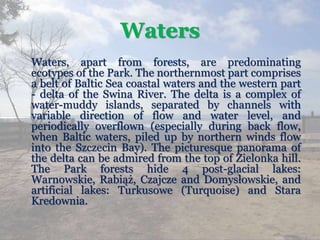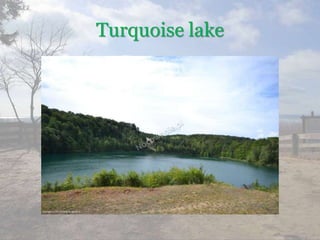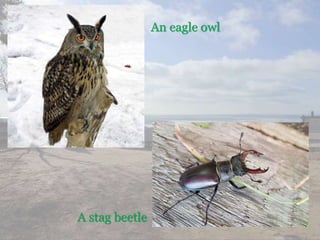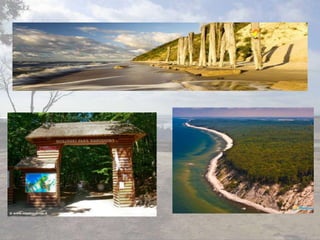Wolin National Park
- 2. LOGO
- 3. Location Wolinski National Park is located at the mouth of the Oder River, in the North- Western Poland (Szczecin voivodeship), close to the Polish-German border. It protects highly valuable north-western part of the Wolin Island.
- 5. History The Park was established in 1960 on the area of 4844 ha. It was extended in 1996 by incorporating 1 nautical mile broad belt of Baltic coastal waters in the north and delta of the Swina River. Inclusion of the part of the Pomeranian Bay and inner salt waters of the Szczecin Bay has made the Wolin National Park the first maritime park in Poland. The total area of the Park today is 10 937 ha, of which forests covering 4530 ha (41%). 6 forest communities of a total area of 165 ha (1,5%) are under strict protection.
- 6. Geography The landscape of the Park varies greatly, including its characteristic element: 15 km long and up to 95 m high cliffs. Storms, wind and sun contribute to the cliffs' erosion. As a result they recede approximately 80 cm per year. The altitude within the Park is from 0 to 115 m. Moraine hills predominate in the relief, covering approximately 75% of the Park area.
- 7. Beach and cliff in the Wolin National Park
- 8. Waters Waters, apart from forests, are predominating ecotypes of the Park. The northernmost part comprises a belt of Baltic Sea coastal waters and the western part - delta of the Swina River. The delta is a complex of water-muddy islands, separated by channels with variable direction of flow and water level, and periodically overflown (especially during back flow, when Baltic waters, piled up by northern winds flow into the Szczecin Bay). The picturesque panorama of the delta can be admired from the top of Zielonka hill. The Park forests hide 4 post-glacial lakes: Warnowskie, Rabiąż, Czajcze and Domysłowskie, and artificial lakes: Turkusowe (Turquoise) and Stara Kredownia.
- 10. Vegetation Over 1300 vascular plant species have been recorded on the Wolin Island. Many of the species are rare and protected, such us sand binders: sea-beach sandwort, lyme grass, sea rocket, spiny saltwort, and salt water plants - halophytes (about 30 species). Steep slopes of the cliffs are densely overgrown by common sea buckthorn. Ground and sandy bed of the Baltic Sea is a habitat of macroalgae: green algae, brown algae and rhodophytes, of which the most frequent are bladderwack and chlorophyte Entetromorpha intestinalis. Inland areas of the Park consist mainly of moraine hills covered with beech-pine- oak forests. The most dominant tree species is though pine, which overgrows 68% of the inland Park area. Beech and oak cover respectively 23% and 7%, and other tree species the rest.
- 12. Fauna The fauna of Wolin is very differentiated and richly represented by rare species. The main flyway of birds along the Baltic coast crosses the island. Over 230 bird species have been recorded within the Park, of which breeding: white- tailed sea eagle, aquatic warbler, dunlin and red-breasted flycatcher. The park is particularly important for preserving habitats of waterfowls, for which it provides peace and feeding grounds, especially during spring and autumn migration. One of the recent projects is reintroduction of eagle owl. Stations of the largest Polish beetle - stag beetle, are examples of the rich insect world. 3 new for science species - beetle Teredus opacus and two species of springtails have been designated within Park borders. Waters of the Pomeranian Bay are biotopes of many species, particularly fish, and sea mammals becoming more and more rare - grey seal and harbour porpoise.
- 13. An eagle owl A stag beetle
- 14. Tourism and culture The turbulent history of Wolin has led to its cultural diversification. Traditional ties with the sea are though extremely strong (fishing culture, trade). Within the Park and in the neighbouring areas one can find remains of strongholds and other places of historic settlements, which are both subject to scientific research and tourist attraction. Tourism is a vital part of activity in the Park. The tourist infrastructure is well developed and comprises educational - historical centre (under equipment), European bison breeding centre, 4 observation points, 3 parking areas, network of tourist routes (combined length approximately 46 km) and educational trails. Turkusowe lake with its specific colour of water, Zielonka hill, European bison breeding centre and observation points Gosań and Kawcza Góra are among especially frequently visited places. Grave dangers to the Park nature are ways, railways connecting the Port of Swinoujście with other regions of Poland, power lines and a gas pipeline. The Park has its own periodical Klify (The Cliffs), where results of its own research as well as scientific description of preservation work in the Park are published.
